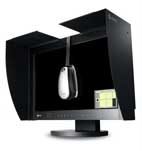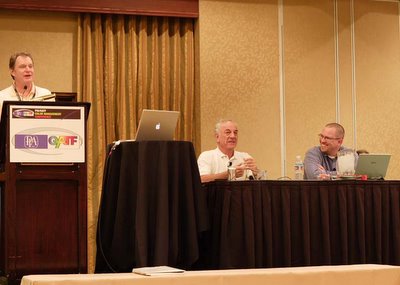Xrite sells an automated print profiling solution, a bundle containing the Xrite DTP70 and Monaco Profiler 4.8. This is based on the DTP 70 spectro, which I started testing two weeks ago. It's been a very pleasant experience.
Until I started working with this Xrite combo, I didn't know printer profiling could be so simple. I was up and running in less than 30 minutes after unpacking the product, and inkjet profiles now take me less than 10 minutes to create.
The DTP70 is a fast compact device that acts like an inkjet printer in reverse: It ingests printed testcharts and scans them. Like an inkjet, it connects to your computer by a USB cable, and takes up little real estate. The only control on the device is the large button — you press this to tell the spectro to start scanning the chart you inserted.
The chart-scanning process requires only a couple of minutes per page. Yes, it's lightning fast!
The spectro hardware has both white and black backing strips for measuring. You can choose which to use by flipping the backing plate. Also, a UV filter can be manually rotated in and out of the measurement path at will—this is a very sensible design, as only some users and some software packages will need the filter. For the record, my position is that photographers who make client prints should not use the filter, while printers who make proofs should.
The Monaco Profiler Platinum software that Xrite supplies to drive the DTP70 has a comprehensive range of color management abilities. It can create scanner and camera profiles, calibrate monitors, create RGB and CMYK printer profiles, and edit ICC profiles. So far I've only exercised the printer profiling part of the package.
Installation of Monaco Profiler on my Powerbook under Panther was a breeze. The software can run anywhere, provided you plug in the dongle. My dongle got programmed remotely by the Xrite Web site during a registration procedure launched during installation. When installing on "fanjet", my noisy dual G5 with Mac OS X Tiger, I had a minor glitch as the HASP dongle driver didn't install automatically. As for Windows, the install on a Win XP machine at Canon's offices (see below) went through flawlessly.
I first profiled my home Epson 2100 inkjet, with two glossy papers and one matte paper, in RGB mode. For this, I used the half-page test chart, the simplest supplied by Monaco Profiler. I verified profile quality visually by means of a print of the Colorchecker template downloaded from Danny Pascale's site, updated with some of my own measured patch data. I also ran off the Pixl test image before printing some of my own portofolio.
When I was quite certain that my homemade inkjet profiles were good, I put the DTP70 in a plastic shopping bag and took it to visit Mr. Mariane, at Canon's headquarters in Paris. Together, we profiled a wide-body Canon inkjet, and a monster RIP-driven Canon laser-printer/copier that costs several hundred thousand dollars.
The copier yielded excellent color-accurate results for the Colorchecker, both in RGB and in CMYK mode, and made visually appealing photo prints, when our Xrite-generated profiles were used. However, to obtain optimal color from such an unstable device, the printer's self-calibration procedure should be invoked to re-linearize, before a print run and before profiling; also, color-sensitive prints should be run off as multiple copies, and the first few pages of each batch of prints should be disregarded.
No product is perfect. However the only weakness I found so far with the DTP70 is that the paper lead-in of a test chart needs to measure close to 30mm or else the paper mechanism will refuse to feed in. This makes it necessary to trim the charts by hand, precisely. But the Print with Preview dialog in Photoshop lets me print charts at exactly the right distance from the paper edge, on A4 sheets, and then the feed mechanism performs very reliably with no need for manual trimming of the page.
Capsule summary: The DTP70 and Monaco Profiler profiling combo is unproblematic to use and lightning fast. This industrial-strength profiling system is perfect for a production environment such as a repro-center or print-room.
I wish to thank Danny Pascale, the author of the Babelcolor color measuring and conversion software, Steve Upton, padrone of Chromix and author of the Colorthink profile evaluation tool, and color specialist Roger Breton for their invaluable assistance while I was struggling with ICC Color Theory 101 during this review.




